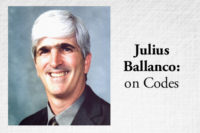
The International Association of Plumbing and Mechanical Officials (IAPMO) has just released the proposed code changes to the Uniform Plumbing Code (UPC). These changes will result in the culmination of the 2009 UPC. However, by the time you read this column, the first recommendations for the action on these code changes will have been completed. This is how quickly the timeline proceeds for the code change process.
In reviewing the changes, there appear to be two distinct approaches taken by the proponents. The majority of the changes seek to move the UPC forward in the direction it has been taking over the past five years. The other changes seek to revert the UPC back to the way it appeared prior to all of the updating.

For Example"
A perfect example is the changes proposed to the alternative approval and engineered design sections of the code. These sections were significantly modified during the last two code change cycles. The current requirements take the straightforward approach of requiring an applicant to submit data, plans, reports, etc., that will prove the acceptability of an alternative or engineered design. If the documentation proved equivalency, the authority having jurisdiction (AHJ) is required to approve the alternative or engineered design.The proposed change seeks to modify the requirements to allow the inspector discretion as to whether to accept an alternative or engineered design. The word “discretion” should set off red flags in everyone. This is a simple term that means, “Well, I don’t like it; so, even if you prove equivalency, I am not going to allow it.” This is what the proponent hopes to accomplish with this change.
While this change is submitted by the proponent as a mere clarification, it will, in effect, change the entire philosophy of the UPC. Is the code a set of rules available for all to use and apply, or is it a hammer for an AHJ to wield with unchecked authoritative power? The vast majority of the IAPMO members want the former.
Another example is the various proposed changes to the bathroom or horizontal wet venting requirements. A few changes seek to clarify the requirements. The additional wording helps to explain the connection requirements for this type of system.
The very next code change seeks to delete the bathroom group wet venting requirements. Keep in mind that this section first appears in the 2006 edition of the code. The reason given for the deletion is that the requirements are confusing and should remain in the appendix. As a voting member of the committee representing the American Society of Plumbing Engineers (ASPE), I just shook my head and said, “What?!”
In total, there are 243 items (code changes) proposed to the plumbing code. More than half of these changes are to the material requirements. Many of the material changes attempt to better identify which standard applies where. These changes are long overdue in making it easier to identify the applicable standard.
If the bulk of the changes are approved, many standards will be referenced throughout the code. In the past, IAPMO had a policy of not listing the standards in the text of the code and only providing a laundry list of the standards in Chapter 14.
The other group of standard changes seeks to update the standards with the latest date.
A New Chapter
There are a series of changes proposed to the new reclaimed and grey water chapter. I authored many of these changes. The new chapter was formed by moving two appendix chapters into the body of the UPC. In the process of moving the appendices, they were not coordinated with the remainder of the code. The two appendices were written as stand-alone documents.
The other problem with the original reclaimed water section is that the requirements were formulated around the jurisdictions in Southern California and Arizona, where the utility supplies reclaimed water through a public system. This resulted in excluding private reclaimed systems that are becoming popular with LEED (Leadership in Energy and Environmental Design) buildings.
The changes would allow the use of private and local reclaimed water. The requirements to have the reclaimed water treated to tertiary levels would remain a part of the requirements. Grey water also could be treated to become reclaimed water. The reclaimed water would be permitted to be used for flushing water closets and urinals in any building.
Once again, there is a change to allow the use of non-water-supplied urinals. The difference to this year’s change is that, rather than 50 to 100 changes, there is a single change proposed. The change is a concentrated effort of those involved trying to gain acceptance of non-water-supplied urinals. The proposal acquiesces to its opponents by requiring a water supply to be piped to non-water-supplied urinals.
This, of course, is rather stupid. If the urinal doesn’t require water, why pipe water to the fixture? The only justification is to use the code as a make-work provision.
Some may state that, with the water present in the wall, it makes it easier for an owner to remodel by adding water-supplied urinals. However, any time an owner remodels a bathroom or toilet room, it usually entails re-piping. This would be no different. So why should the code penalize an owner with higher costs just in case, some day, they may decide to change their urinals? The change should be approved without the requirement for water piping.
A few other changes address mechanical devices to serve as traps. The concept comes from the United Kingdom. There are straight-pipe mechanical membrane devices that are supposed to replace a trap. The membrane opens to allow the flow of water and waste, and closes at the completion of flow to close off the opening.
One change seeks to allow these devices; another change proposes to prohibit such devices. The problem with any of these changes is that there is no consensus standard regulating these alternative trap devices. Without a standard to regulate the performance of such a device, it is virtually impossible to add it to the code.
The proponent is attempting to develop an American Society of Mechanical Engineers’ (ASME) standard for the device. However, the concept has not been warmly received by the ASME A112 Committee.
If you would like to review all of the changes proposed to the UPC, you can download the monograph from the IAPMO Web site, www.iapmo.org. The Web site will also post the results of the first code meeting.


